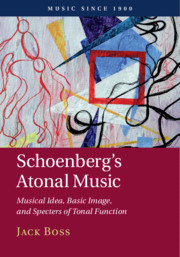Book contents
- Schoenberg’s Atonal Music
- Music Since 1900
- Schoenberg’s Atonal Music
- Copyright page
- Dedication
- Contents
- Music Examples
- Acknowledgments
- Abbreviations and Notational Conventions
- 1 Tonal oder Atonal?
- 2 Piano Pieces Op. 11, Nos. 2 and 3
- 3 Das Buch der hängenden Gärten, Op. 15, Nos. 7 and 11
- 4 Erwartung, Op. 17
- 5 Six Little Piano Pieces, Op. 19 (Nos. 2, 3, and 6)
- 6 Pierrot lunaire, Op. 21, Nos. 1, 14, and 21
- 7 Summary, and the Way Forward to Twelve-Tone Music
- Bibliography
- Index
- By the same author
3 - Das Buch der hängenden Gärten, Op. 15, Nos. 7 and 11
Basic Images in Two of the Earliest Atonal Pieces
Published online by Cambridge University Press: 28 June 2019
- Schoenberg’s Atonal Music
- Music Since 1900
- Schoenberg’s Atonal Music
- Copyright page
- Dedication
- Contents
- Music Examples
- Acknowledgments
- Abbreviations and Notational Conventions
- 1 Tonal oder Atonal?
- 2 Piano Pieces Op. 11, Nos. 2 and 3
- 3 Das Buch der hängenden Gärten, Op. 15, Nos. 7 and 11
- 4 Erwartung, Op. 17
- 5 Six Little Piano Pieces, Op. 19 (Nos. 2, 3, and 6)
- 6 Pierrot lunaire, Op. 21, Nos. 1, 14, and 21
- 7 Summary, and the Way Forward to Twelve-Tone Music
- Bibliography
- Index
- By the same author
Summary
Chapter 3 turns its attention to the “Book of the Hanging Gardens” songs, Op. 15 – some of Schoenberg’s earliest atonal pieces. As settings of texts by Stefan George, these songs illustrate the large framework I call “basic image.” A basic image distills a visual shape of some sort from the poem’s first few lines of text, then uses it to control various aspects of the song’s pitch and rhythm. In Op. 15, No. 7, “Angst und Hoffen,” the basic image is of a lover turning his face alternately upward toward hope and downward toward fear (that his beloved would be lost to him), while his body first constricts, then expands to emit longer and longer sighs. In Op. 15, No. 11, “Als wir hinter dem beblümten Tore,” the guiding image is that of a memory (of a past tryst with the beloved) in the lover’s mind that disappears, but is at least partially recovered after some striving. This second image has points in common with the other kind of framework, the “musical idea.”
Keywords
- Type
- Chapter
- Information
- Schoenberg's Atonal MusicMusical Idea, Basic Image, and Specters of Tonal Function, pp. 111 - 151Publisher: Cambridge University PressPrint publication year: 2019



